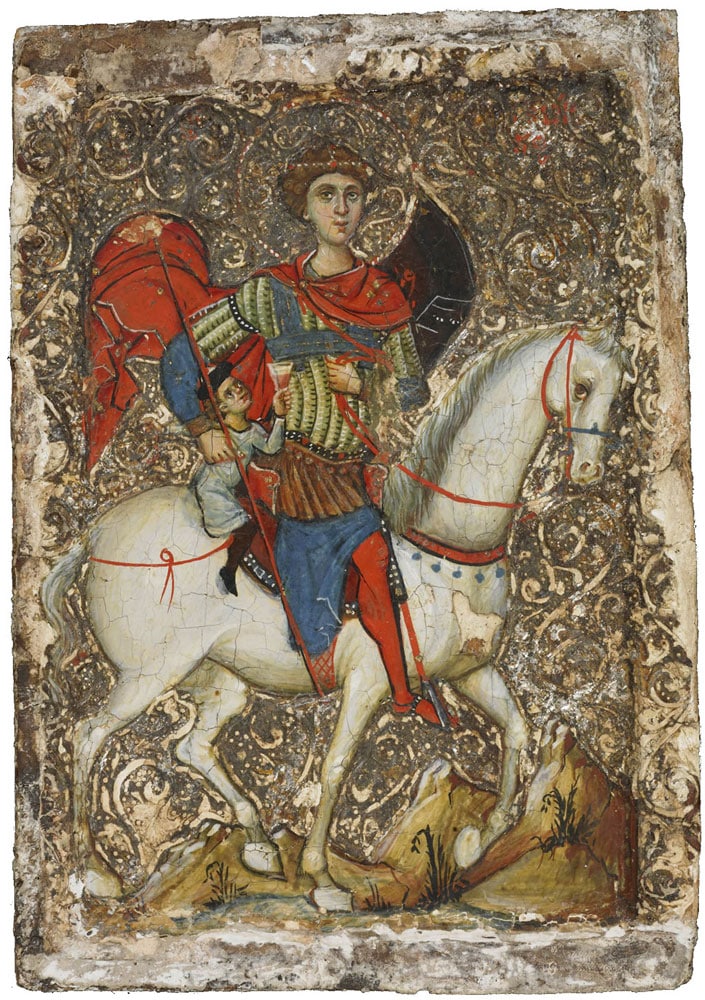The icon is painted in egg tempera on a pine panel primed with gesso over linen. The background gesso is worked in relief, originally silvered. On the reverse is a patriarchal cross painted in red. The icon represents a young beardless saint on horseback. He is identified by an abraded, but just readable, Greek inscription in red letters, which identifies him as St George. He is shown on a white horse with a red harness. He is not alone on the horse but sitting behind him is a much smaller figure holding a glass of red wine. St George wears a diadem, and a red cloak flies out from his shoulders. He wears a ribbed cuirass over a blue tunic and red hose. He carries a red lance. The small figure wears a pale blue tunic and black hose. Below the white horse is a mountainous landscape and the sea. The rest of the background and the saint’s halo are of gesso modeled into a three-dimensional scroll pattern on which there are traces of silver. Much of the gesso has been lost from the edges of the panel, and parts of the red paint are abraded.
The subject of the icon was identified by Cormack and Mihalarias (1984) from the Greek text of the posthumous miracles of St George. The small figure is a young Christian from Mytilene, in captivity on the island of Crete. According to the text the boy had been snatched from his family and forced to serve his Saracen masters with food and drink but, in the very act of offering a glass of wine to his captors, he was rescued by St George and carried home across the Aegean Sea. The three-dimensional scrollwork, originally silvered, imitates the precious metal revetments found on some icons.
The date of the middle of the 13th century suggested for this icon depends primarily on a comparison with the wall paintings in the Kalenderhane Camii in Istanbul (Striker and Doğan Kuban 1977), which include representations of St Francis and belong to the Latin period of Constantinople from 1204 to 1261, and also with the miniatures of the Arsenal Bible (Paris, Arsenal, 5211). Both these paintings belong to the middle of the 13th century and were painted by artists who came with the Crusaders to the East. The artist of the British Museum icon also shows some characteristics of style derived from the West, and for this reason, it is suggested that either he or his master had been trained in Paris. But the artist was well versed in Byzantine iconography, and for this reason, it can be assumed that he was working in the Byzantine East. Various suggestions have been made about the provenance of this icon, including Cyprus, Acre, Lydda, and even the Monastery of St Catherine at Sinai. It has been suggested (Cormack 2007) that the same painter produced a number of icons which are now in the collection at Sinai, and that he did indeed work in the monastery, perhaps producing icons for Western pilgrims or for other Christians in the monastery. These connections with other icons have been based not only on style but also on similarities of techniques of working. The technical features (such as the use of parchment in building up the gesso frame around the panel) are discussed more fully elsewhere (Harrison et al. 2008).
Mouriki (1985-6) reversed the stylistic arguments and argued for a Cypriote artist influenced by Western art of the period. This is an important argument as it exposes the problems of art in the Crusader period when eastern and western artists (and their work) impinged on each other, and each “side” took ideas from the other. However, if the additional attributions to this artist in the Sinai collection are accepted, his Western affiliations would be confirmed by the fact that his repertoire included the scene of the Coronation of the Virgin, a subject not acceptable to an Orthodox Christian.
Literature: J. Aufhausser, Miracula S. Georgii, Leipzig 1913, chap. 9, 100–3; R. Cormack and S. Mihalarias, ‘A Crusader Painting of St George: ‘maniera greca’ or ‘lingua franca’, Burlington Magazine 126 (1984), 132–41; D. Mouriki, ‘Thirteenth-Century Icon Painting in Cyprus’, The Griffon, n.s., 1-2 (1985-6), 9–112; M. Acheimastou-Potamianou (ed.), From Byzantium to El Greco. Greek Frescoes and Icons (exh. cat., Royal Academy of Arts), Athens, 1987, 150–1, no. 9; J. Folda, ‘The Saint Marina Icon: Maniera Cypria, Lingua Franca, or Crusader Art’, in B. Davezac (ed.), Four Icons in the Menil Collection, Austin and Houston, 1992, 109; D. Buckton (ed.), Byzantium: Treasures of Byzantine Art and Culture from British Collections (exh. cat., The British Museum), London, 1994, 176, no. 191; H.C. Evans and W.D. Wixom (eds), The Glory of Byzantium. Art and Culture of the Middle Byzantine Era A.D. 843–1261 (exh. cat., The Metropolitan Museum of Art), New York, 1997, 395, no. 261; C. L. Striker and Y. Doğan Kuban (eds), Kalenderhane in Istanbul. The Buildings, Their History, Architecture, and Decoration, Mainz, 1997, esp. 142 for the parallels; R. Cormack, ‘Crusader art and artistic technique: another look at a painting of St George’, in M. Vassilaki (ed.), Byzantine Icons. Art, Technique and Technology, Herakleion, 2002, 163–9; P. Grotowski, ‘The Legend of St. George Saving A Youth from Captivity and Its Depiction in Art’, Series Byzantina (Warsaw), 1 (2003), 27–77; J. Folda, Crusader Art in the Holy Land, from the Third Crusade to the Fall of Acre 1187–1291, Cambridge, 2005, esp. 329ff.; R. Cormack, Icons, London, 2007 (repr. 2014), 70–83, 116, no. 13; J. Folda, Crusader Art. The Art of the Crusaders in the Holy Land, 1099–1291, Aldershot, 2008, esp. 122. L. Harrison, R. Cormack, C.R. Cartwright and J. Ambers, ‘An Icon of St. George: preparation for a portrait of a saint’, in J.H. Townsend, T. Doherty, G. Heydenreich and J. Ridge (eds), Preparation for Painting: The Artist’s Choice and its Consequences, London, 2008, 14–21.
Robin Cormack
